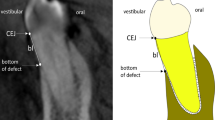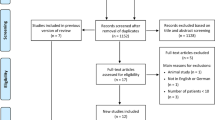Abstract
Objectives
Accurate imaging is essential for effective treatment planning in periodontology. The aim of this ex vivo study was to investigate the accuracy of cone beam computed tomography (CBCT) and digital periapical radiographs (PA) in imaging periodontal defects. Hypotheses are: 1. That CBCT is a more accurate method than PA concerning vertical measurements of periodontal bone defects2. That CBCT itself is an accurate method to describe vertical periodontal bone loss
Material and methods
In this study, 117 periodontal defects from 10 human cadavers were investigated radiographically by CBCT and PA by one calibrated observer. Afterwards the vertical bone loss was measured with a periodontal probe by the same calibrated observer. Differences between radiographic and clinical measurements were calculated and analyzed. Bland-Altmann plots including 95% limits of agreement were calculated.
Results
The 95% limits of agreement ranged from 3.29 to −3.27 mm between clinical measurements and measurements in PAs, and from 2.13 to −1.97 mm in CBCTs. The mean difference between clinical and radiographic measurements was 0.0009 mm for PA and 0.0835 mm for CBCT.
Conclusions
When comparing the clinical measurements, CBCT had a higher agreement and less deviations than PAs, and CBCT seems to be an accurate method to describe vertical periodontal bone loss.
Clinical relevance
Accurate description of defects is helpful for accurate treatment planning.



Similar content being viewed by others
References
Holtfreter B, Kocher T, Hoffmann T, Desvarieux M, Micheelis W (2010) Prevalence of periodontal disease and treatment demands based on a German dental survey (DMS IV). J Clin Periodontol 37(3):211–219. https://doi.org/10.1111/j.1600-051X.2009.01517.x
Baehni P, Tonetti MS (2010) Group 1 of the European Workshop on P. Conclusions and consensus statements on periodontal health, policy and education in Europe: a call for action--consensus view 1. Consensus report of the 1st European Workshop on Periodontal Education. Eur J Dent Educ 14(Suppl 1):2–3. https://doi.org/10.1111/j.1600-0579.2010.00619.x
Albandar JM, Tinoco EM (2002) Global epidemiology of periodontal diseases in children and young persons. Periodontology 2000 29:153–176
Armitage GC (2004) Periodontal diagnoses and classification of periodontal diseases. Periodontology 2000 34:9–21
Nielsen IM, Glavind L, Karring T (1980) Interproximal periodontal intrabony defects. Prevalence, localization and etiological factors. J Clin Periodontol 7(3):187–198
Persson RE, Hollender LG, Laurell L et al (1998) Horizontal alveolar bone loss and vertical bone defects in an adult patient population. J Periodontol 69(3):348–356. https://doi.org/10.1902/jop.1998.69.3.348
Aljehani YA (2014) Diagnostic applications of cone-beam CT for periodontal diseases. Int J Dent 2014:865079. https://doi.org/10.1155/2014/865079
Kang JH, Lee KS, Oh MG, Choi HY, Lee SR, Oh SH, Choi YJ, Kim GT, Choi YS, Hwang EH (2014) The incidence and configuration of the bifid mandibular canal in Koreans by using cone-beam computed tomography. Imaging Sci Dent 44(1):53–60. https://doi.org/10.5624/isd.2014.44.1.53
Leite GM, Lana JP, de Carvalho Machado V et al (2014) Anatomic variations and lesions of the mandibular canal detected by cone beam computed tomography. Surg Radiol Anat. https://doi.org/10.1007/s00276-013-1247-5
Long H, Zhou Y, Ye N, Liao L, Jian F, Wang Y, Lai W (2014) Diagnostic accuracy of CBCT for tooth fractures: a meta-analysis. J Dent 42(3):240–248. https://doi.org/10.1016/j.jdent.2013.11.024
de Toubes KM, Cortes MI, Valadares MA et al (2012) Comparative analysis of accessory mesial canal identification in mandibular first molars by using four different diagnostic methods. J Endod 38(4):436–441. https://doi.org/10.1016/j.joen.2011.12.035
Blattner TC, George N, Lee CC, Kumar V, Yelton CDJ (2010) Efficacy of cone-beam computed tomography as a modality to accurately identify the presence of second mesiobuccal canals in maxillary first and second molars: a pilot study. J Endod 36(5):867–870. https://doi.org/10.1016/j.joen.2009.12.023
Tonetti MS, Pini Prato G, Williams RC et al (1993) Periodontal regeneration of human infrabony defects. III. Diagnostic strategies to detect bone gain. J Periodontol 64(4):269–277. https://doi.org/10.1902/jop.1993.64.4.269
Noujeim M, Prihoda T, Langlais R, Nummikoski P (2009) Evaluation of high-resolution cone beam computed tomography in the detection of simulated interradicular bone lesions. Dentomaxillofac Radiol 38(3):156–162. https://doi.org/10.1259/dmfr/61676894
Reynolds MA, Kao RT, Camargo PM, Caton JG, Clem DS, Fiorellini JP, Geisinger ML, Mills MP, Nares S, Nevins ML (2015) Periodontal regeneration - intrabony defects: a consensus report from the AAP regeneration workshop. J Periodontol 86(2 Suppl):S105–S107. https://doi.org/10.1902/jop.2015.140378
Nikolic-Jakoba N, Spin-Neto R, Wenzel A (2016) Cone beam computed tomography for detection of intrabony and furcation defects: a systematic review based on a hierarchical model for diagnostic efficacy. J Periodontol:1–19. https://doi.org/10.1902/jop.2016.150636
Choi IGG, Cortes ARG, Arita ES, Georgetti MAP (2018) Comparison of conventional imaging techniques and CBCT for periodontal evaluation: a systematic review. Imaging Sci Dent 48(2):79–86. https://doi.org/10.5624/isd.2018.48.2.79
Duckworth JE, Judy PF, Goodson JM, Socransky SS (1983) A method for the geometric and densitometric standardization of intraoral radiographs. J Periodontol 54(7):435–440. https://doi.org/10.1902/jop.1983.54.7.435
Eickholz P, Benn DK, Staehle HJ (1996) Radiographic evaluation of bone regeneration following periodontal surgery with or without expanded polytetrafluoroethylene barriers. J Periodontol 67(4):379–385. https://doi.org/10.1902/jop.1996.67.4.379
Abbas F, Hart AA, Oosting J et al (1982) Effect of training and probing force on the reproducibility of pocket depth measurements. J Periodontal Res 17(2):226–234
Schulze R, Heil U, Gross D et al (2011) Artefacts in CBCT: a review. Dentomaxillofac Radiol 40(5):265–273. https://doi.org/10.1259/dmfr/30642039
Caliskan A, Sumer AP (2017) Definition, classification and retrospective analysis of photostimulable phosphor image artefacts and errors in intraoral dental radiography. Dento maxillo facial radiology. 46(3):20160188. https://doi.org/10.1259/dmfr.20160188
Team RC 2013 R: a language and environment for statistical computing: R foundation for statistical computing. Vienna, Available from: http://www.R-project.org/
Matthias Gamer JL, Ian Fellows Puspendra Singh 2012 Irr: various coefficients of interrater reliability and agreement. R package version 0.84. Available from: http://CRAN.R-project.org/package=irr
Dahl DB 2013 xtable: Export tables to LaTeX or HTML. R package version 1.7–1. Available from: http://CRAN.R-project.org/package=xtable
Berkelaar M 2013 lpSolve: Interface to Lp_solve v. 5.5 to solve linear/integer programs. R package version 5.6.7. Available from: http://CRAN.R-project.org/package=lpSolve
Mol A, Balasundaram A (2008) In vitro cone beam computed tomography imaging of periodontal bone. Dentomaxillofac Radiol 37(6):319–324. https://doi.org/10.1259/dmfr/26475758
Kalender WA, Kyriakou Y (2007) Flat-detector computed tomography (FD-CT). Eur Radiol 17(11):2767–2779. https://doi.org/10.1007/s00330-007-0651-9
Misch KA, Yi ES, Sarment DP (2006) Accuracy of cone beam computed tomography for periodontal defect measurements. J Periodontol 77(7):1261–1266. https://doi.org/10.1902/jop.2006.050367
Lindhe J (2005) Clinical periodontology and implant dentistry. In: Lindhe J (ed), 4th edn. vol 1:28
Kim TS, Benn DK, Eickholz P (2002) Accuracy of computer-assisted radiographic measurement of interproximal bone loss in vertical bone defects. Oral Surg Oral Med Oral Pathol Oral Radiol Endod 94(3):379–387
Horr T, Kim TS, Hassfeld S et al (2005) Accuracy of assessing infrabony defects using a special digital filter for periodontal bone loss. Am J Dent 18(1):50–56
Horner K, Islam M, Flygare L, Tsiklakis K, Whaites E (2009) Basic principles for use of dental cone beam computed tomography: consensus guidelines of the European Academy of Dental and Maxillofacial Radiology. Dentomaxillofac Radiol 38(4):187–195. https://doi.org/10.1259/dmfr/74941012
Acknowledgements
Special thanks to Prof Dr. Christian Mertens and Mrs. Henriette Waldecker of the Department of dento-maxillofacial surgery of the University hospital Heidelberg for their technical support and to Dr. Dorothee Schuessler of the Department of Restorative dentistry of the University Hospital Heidelberg for the English language editing.
Funding
The work was supported by the Department of operative Dentistry and the Department of dento-maxillofacial surgery of the University hospital Heidelberg, There was no funding.
Author information
Authors and Affiliations
Corresponding author
Ethics declarations
Conflict of interest
All authors declare that they have no conflict of interest.
Ethical approval
All procedures performed in studies involving human participants were in accordance with the ethical standards of the institutional and national research committee and with the 1964 Helsinki declaration and its later amendments or comparable ethical standards.
Informed consent
Informed consent was obtained from all individual participants included in the study. The study was approved by the ethical review board of the University of Heidelberg (S-410/2015).
Additional information
Publisher’s note
Springer Nature remains neutral with regard to jurisdictional claims in published maps and institutional affiliations.
Rights and permissions
About this article
Cite this article
Ruetters, M., Hagenfeld, D., ElSayed, N. et al. Ex vivo comparison of CBCT and digital periapical radiographs for the quantitative assessment of periodontal defects. Clin Oral Invest 24, 377–384 (2020). https://doi.org/10.1007/s00784-019-02933-w
Received:
Accepted:
Published:
Issue Date:
DOI: https://doi.org/10.1007/s00784-019-02933-w




